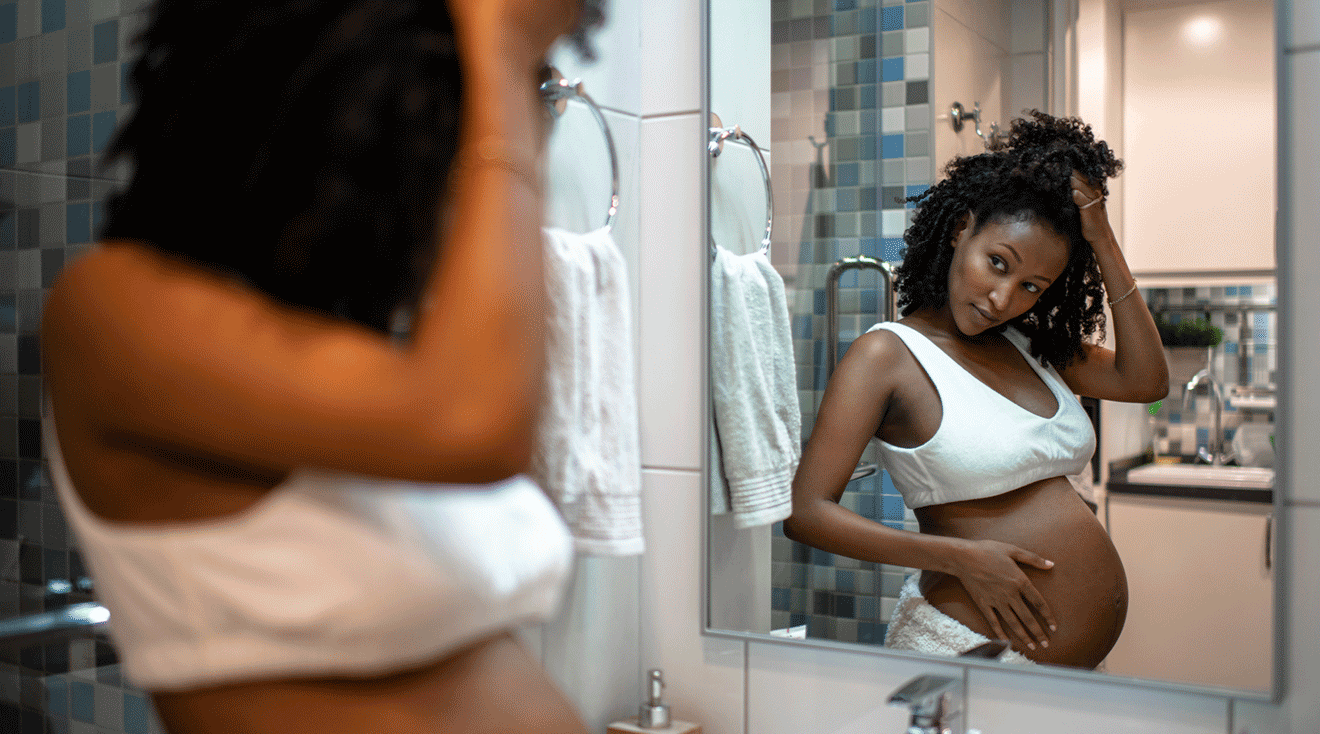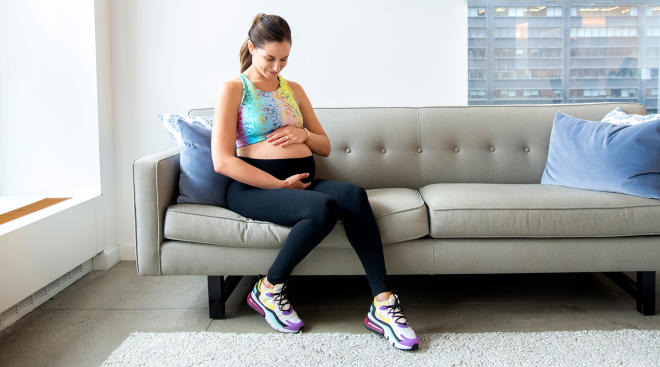Should You Groom for the Delivery Room?
As your due date approaches, you might be wondering how best to prepare for the big day. You have your phone chain ready and your hospital bag packed—perhaps you even have a mani-pedi appointment in the books. There’s really no right or wrong to get yourself physically and mentally geared up for what’s ahead. You just want to feel good in your own skin. It’s not everyone’s cup of tea, but for some moms-to-be this includes some pre-labor primping, whether that means full hair and makeup or a date with a razor. Of course, you should do whatever makes you feel best. (And if that means throwing your mane into a messy bun and calling it a day, go for it!) Basically, when it comes to grooming for the delivery room—you do you.
There are no rules here—and what works for someone you see on Instagram may not work for you. “The labor and delivery process is all about what the mom-to-be wants and needs,” says Monica Carter, MS, FNP-BC, a family nurse practitioner in obstetrics and gynecology at Georgetown University Hospital in Washington, DC. “There are no universal dos or don’ts for grooming or primping for labor.”
That said, for some people, having their hair and makeup done for delivery can boost their confidence and enhance their mood. Many brands offer pregnancy-safe makeup and skin care products—but keep in mind there are some makeup ingredients to avoid during pregnancy.
When it comes to hair, it’s generally considered safe to dye your hair while pregnant, though it’s best to stay away from certain harmful ingredients and talk to your provider if you have any doubts. As for the big day, bring a curling iron if you so choose—or don’t. The rules are there are no rules!
Some moms find that doing their hair or makeup helps them feel more comfortable in an uncomfortable situation. “Grooming and primping during pregnancy and childbirth can help you feel comfortable and confident during this transformative time,” says Nikia Grayson, DNP, CNM, midwife and chief clinical officer at Choices: Center for Reproductive Health in Memphis, Tennessee.
Carter says she loves seeing moms-to-be enhance their experience with personal comforts—and it’s not just about hair and makeup. “Being in obstetrics and gynecology for 15 years, I’ve loved seeing how trends change,” she says. “Patients are now showing up with embroidered onesies and hospital bags, their own blankets, pajamas and robes, and coming with lashes, protective styles such as braids or high buns, and all of their electronics.”
Experiences—and what makes moms-to-be feel beautiful—vary across the board. Tiffany, a mom of two, brought her own hospital gown and headband to wear for her son’s birth. “My nurses told me I looked the cutest right before it was time to push, and—not going to lie—it was a morale boost!” she says.
Janelle, a mom of four, chose to forgo the beauty routine. “Makeup and curling irons were the last things I was thinking about when preparing to have a baby,” she says. “There’s nothing more real and beautiful than being natural for the birth of your baby.”
Since you’ll be exposed during labor and delivery, you might be wondering if grooming “down there” is generally expected. Again, the answer is: Do what makes you feel best. “We as the health-care team don’t care—and probably won’t even notice—if you’re clean-shaven or not,” says Carter. If you’re having a c-section, your provider might trim your pubic hair before the procedure, she adds. If you want to remove hair in advance, Carter suggests trimming over shaving, as “razors can harbor harmful bacteria, and shaving can cause microabrasions on the skin which can increase the risk for infection.”
Grayson adds that your body’s hormonal changes might make your skin more sensitive to pain, so be forewarned if you do keep up with your waxing appointments. Either way, know that your provider couldn’t care less, so there’s no shame in your game, whether you’re smooth and bare or sporting fuzzy legs.
Whether you’re going glam or keeping things natural for baby’s grand entrance, it’s key to prioritize your confidence and comfort.
These tips will help you look and feel your best:
- Maintain good hygiene. The bread-and-butter stuff is important, says Grayson: This means regular showers, brushing your teeth and washing your hair. Beyond the basics, everything else is up to personal preference.
- Moisturize. Pregnancy can lead to dry skin—among other skin issues. Use a gentle, pregnancy-safe moisturizer to keep skin hydrated and prevent itching, says Grayson.
- Avoid aggressive treatments. Grayson says that because your skin is more sensitive in pregnancy, it’s best to stay away from intense beauty procedures like chemical peels, microdermabrasion or laser treatments until after baby arrives.
- Keep hair fuss-free. A low-maintenance hairstyle will keep you from worrying about your hair during labor and delivery. “Hairstyles that won’t hurt your head when lying down are best!” Carter advises. Cassie, the first-time mom, suggests a protective hairstyle: “Having braids means I don’t have to wash or style my hair, and it’ll be one less thing to worry about once baby is born,” she says.
- Don’t overdo it with makeup. Too much makeup can clog your pores or irritate your skin, says Grayson. (Also, let’s be real: It could run down your face since you’re likely to sweat during labor and delivery.)
- Bring your own labor gown. A simple way to personalize your labor and delivery experience is bringing a gown to wear during your hospital stay.
- Manis and pedis are fine. Manicures and pedicures are generally safe during pregnancy, says Grayson, although you should be mindful of harsh chemicals that could cause irritation and infections.
- Try to minimize stress. Like we said, looking good is about feeling good. “Stress can impact both you and your baby’s well-being,” says Grayson. “Consider relaxation techniques like deep breathing or prenatal massages.”
- Avoid beauty experimentation for now. It’s wise to avoid trying any new hair, makeup or skin treatments right before labor and delivery, advises Carter. You don’t want to deal with an allergic reaction or rash during your last weeks of pregnancy.
- Don’t do it for the ‘gram—unless that’s truly your thing. “Don’t feel as though you have to be glamorous, or take Instagram-worthy pictures, in labor,” says Carter. “Many moms-to-be come with a fresh face and a ‘mom bun,’ ready for the journey!” Of course, if you want to glam it up, then do your thing!
We all have different beauty standards, and during labor and delivery it’s important to stick to what makes you look and feel good, regardless of what your best friend—or that influencer on Instagram—is doing. As long as you feel good about yourself and prepared (or as prepared as you can be!) for the journey ahead, that’s all that matters. And if you feel your confidence waning at any point, just remember: It’s okay to look like someone who’s in labor or just gave birth, because that’s exactly what happened.
Please note: The Bump and the materials and information it contains are not intended to, and do not constitute, medical or other health advice or diagnosis and should not be used as such. You should always consult with a qualified physician or health professional about your specific circumstances.
Plus, more from The Bump:
Monica Carter, MS, FNP-BC, is a family nurse practitioner in obstetrics and gynecology at Georgetown University Hospital in Washington, DC.
Nikia Grayson, DNP, CNM, MPH, MSN, MA, FNP-C, FACNM, is a midwife and chief clinical officer at Choices: Center for Reproductive Health in Memphis, Tennessee.
Learn how we ensure the accuracy of our content through our editorial and medical review process.
Navigate forward to interact with the calendar and select a date. Press the question mark key to get the keyboard shortcuts for changing dates.




















































